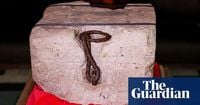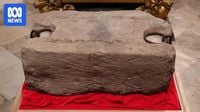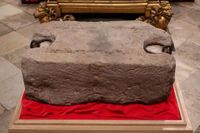An Australian man has been charged with malicious mischief after allegedly attempting to smash the glass case protecting the Stone of Destiny at Perth Museum in Scotland, stirring renewed attention on this centuries-old symbol of Scottish heritage and monarchy.
Arnaud Harixcalde Logan, 35, whose address is listed as Sydney, appeared at Perth Sheriff Court on Monday, July 14, 2025. He faces charges related to vandalism, specifically "malicious mischief," after an incident on Saturday, July 12, when he reportedly tried to break the display case housing the Stone of Destiny, also known as the Stone of Scone. Logan did not enter a plea and was remanded in custody until his next hearing, scheduled for the week of July 21.
The incident occurred at around 2 p.m. local time, when visitors at Perth Museum—about 50 kilometers north of Edinburgh—witnessed a man in a kilt attempting to smash the protective glass case. The museum responded by evacuating visitors as a precaution and temporarily closing the "Stone of Destiny Experience," posting a notice on its website that read: "Please be aware that The Stone of Destiny Experience is currently unavailable due to an earlier incident. Perth Museum remains open and we look forward to seeing you soon." Police were called to what they described as a "public order disturbance," and swiftly arrested Logan.
Despite the alleged attack, Culture Perth and Kinross, the organization overseeing the museum, confirmed that the Stone of Destiny itself was not damaged during the incident. The museum employs "various round-the-clock security measures" to protect this invaluable artifact, underscoring its cultural and historical significance.
The Stone of Destiny weighs approximately 335 pounds (150 kilograms) and is a sandstone block that has played a central role in Scottish history. It was traditionally used in the coronation ceremonies of medieval Scottish monarchs at Scone Abbey near Perth. However, its story took a dramatic turn in the 13th century when King Edward I of England seized the stone and transported it to Westminster Abbey in London. There, the stone was placed beneath the coronation chair, symbolizing English dominion over Scotland.
Since then, the Stone of Destiny has been a potent emblem of Scottish identity and nationalism, as well as a symbol of the union between the English and Scottish crowns that occurred in the 17th century. The stone has been used in the coronations of English and later British monarchs for centuries, including Queen Elizabeth II in 1953 and King Charles III in 2023.
Scottish nationalists have long been uneasy about the stone’s presence in London. Their sentiments culminated in 1950 when four university students from Glasgow famously stole the stone from Westminster Abbey in a daring act of nationalist protest. The stone was returned in time for Queen Elizabeth II’s coronation, but the episode remains a defining moment in its modern history.
In 1996, after 700 years, the stone was officially returned to Scotland and placed on display at Edinburgh Castle. This move was made with an understanding that the stone would be temporarily returned to England for future coronations, a protocol followed during King Charles III’s recent coronation in 2023. For that event, the stone was transported secretly and under tight security back to London, reflecting its enduring importance.
In 2024, the Stone of Destiny was moved to the newly renovated Perth Museum, which underwent a £27 million ($55 million AUD) redevelopment. The museum now serves as the stone’s permanent home, where it continues to attract visitors fascinated by its rich history and symbolic significance.
The recent incident involving Arnaud Logan has reignited discussions about the stone’s place in Scottish culture and identity. A tourist who recorded the event claimed that Logan "claimed to be the leader of his clan, insisting he has a rightful claim to the throne," adding an intriguing layer of personal motive to the episode. However, the full details of Logan’s intentions remain under investigation.
Legal experts note that under Scots law, "malicious mischief" is an offense akin to vandalism, involving damage or destruction of property. Logan’s charge reflects the seriousness with which authorities treat any threat to this treasured artifact.
As the case proceeds, the Scottish public and observers worldwide watch closely, aware that the Stone of Destiny is more than just a relic—it is a symbol that embodies centuries of history, national pride, and the complex relationship between Scotland and the United Kingdom.
The museum and officials have reassured the public that security measures remain robust and that the stone is safe. Meanwhile, Logan remains in custody, awaiting his next court appearance, as the story of the Stone of Destiny continues to unfold in the modern era.






